The study of the properties of nanomaterials. Рубрика в журнале - Nanotechnologies in Construction: A Scientific Internet-Journal
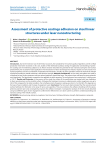
Assessment of protective coatings adhesion on steel linear structures under laser nanostructuring
Статья научная
Introduction. Due to the extensive use of steel linear structures, the standards for the surface quality of pipelines used for oil fluid production have been increased. In this case, studies of the interfacial boundary during the application and bonding of protective coatings are the interesting subjects to do. Recent research describes the potential of laser nanostructuring for steel surface pretreatment prior to polymer layer application. The introduction of laser technology into industry requires not only research on surface properties, but also an evaluation of operational characteristics. Usually, the semi-quantative criteria of mechanical strength of polymer bonding to metallic substrate is the adhesive strength. Methods and Materials. In this study, steel plates were used as a substrate for laser surface treatment with two pulsed ytterbium-doped fiber lasers. The polymer layer was based on epoxy-phenolic resin liquid paint. The liquid paint composition was applied via airless spraying. The curing process was carried out in a drying oven at 150 °C. Results and Discussion. In the process of the study, the surface of the metal plates was treated with laser irradiation to form nanostructures on the metallic surface. Following this treatment, increase in submicroscale surface roughness was up to 230–470% compared to the initial condition. Pull-of adhesion tests of polymer coating vary from 2.2 to 20.6 MPa. This depends on the type of laser irradiation and the type of equipment used. Conclusion. The test results demonstrated that the nanostructured surface facilitates the formation of an array of nano-scale asperities. This array enhances the adhesive bonding with the epoxyphenolic polymer layer and, consequently, improves the adhesive strength. A comparative analysis of the test results obtained using two different types of laser equipment confirmed the effectiveness of a laser system to perform combined polishing and nanostructuring of the metallic surface.
Бесплатно
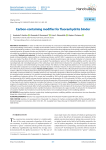
Carbon-containing modifier for fluoranhydrite binder
Статья научная
Introduction. In order to widen the functionality of construction and building materials and widespread electrically conductive building constructions, it is highly recommended to reduce cost of the solutions. This can be achieved by replacing binders with the industrial by-products. At the same time, there are a few articles about adjustment of electrically conductive properties of materials based on by-product binders and this field is of a great importance. Also, highly dispersed particles in modifiers and their role might be considered as important to find out, especially when such additives are used to improve structure and properties of composites. Methods and materials. To study the possibility of controlling the electrical properties of the matrix, compositions based on fluoroanhydrite, sodium sulfate as a hardening activator, and UPC-MIX-1 suspension as an electrically conductive additive, were made. The effect of UPC-MIX-1 suspension on the electrical performance and structure formation of a mineral matrix containing dispersed carbon black particles was studied. The polydisperse nature of the modifying additive and the ratio of the nanodispersed and microdispersed parts of the solid phase were determined. Indicators for calculating the specific volumetric electrical resistance were determined by the probe method. The influence of the dispersed additive on the characteristics of the fluoroanhydrite composite was evaluated by standard laboratory methods. Features of structure formation were evaluated using the methods of physicochemical analysis. Results and discussion. It was confirmed that a fluoranhydrite-based mineral binder with sodium sulfate has moderate physical mechanical properties and might be used as a substitute for gypsum binder. The usage of an electrically conductive additive as a modifier enhances such mechanical properties as flexural compressive strength and compressive strength which increase by 51% and 65% correspondingly. Also, hydro physical properties have been improved, for instance the coefficient of softening for the FD-4 sample has increased by 39%, and the water absorption by mass for the same sample has decreased by 36%. Specific volume electrical resistance has decreased by 49–52% and equals13,6 kOm • cm, 8% of electrically conductive additive being added. The physical and technical properties of the presented composite are due to significant changes of the physical and chemical properties including the features of structure formation. Conclusions. The obtained compositions require extra optimization in order to be used as a heating component. At the same time, the achieved electrical conductivity is sufficient to level the electrostatic effect of self-leveling floors. Regularities in the formation of the structure of the fluoroanhydrite composite have been established, which manifest themselves in the formation of a larger number of contacts for the intergrowth of crystalline hydrate new formations ensured by the presence of a nanodispersed part in the modifying additive.
Бесплатно
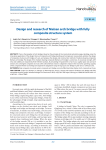
Design and research of Nielsen arch bridge with fully composite structure system
Статья научная
China is the kingdom of arch bridges. Based on the principle of structural elastic potential energy standing value, the innovative application of the design theory of composite arch bridge bending and compression is presented, optimize the design of composite structural arch bridge arch axis, and propose the design and construction method of medium-bearing composite Nielsen arch bridge. The design of the medium-bearing composite Nielsen arch bridge is carried out, its structural strength, stiffness and stability are analyzed by finite element analysis. By simulating the parameters of arch axis, sagittal span ratio and arch section, the convergent composite arch axis with solid web foot section is adopted to improve the economic spanning capacity of the composite Nielsen arch bridge and expand the adaptation range of large span arch bridge in plain area or soft base area.
Бесплатно
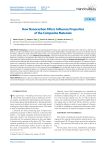
How Nanocarbon Fillers Influence Properties of the Composite Materials
Статья научная
Introduction. Currently the most promising type of repair uses composite materials to fill in fractures or fracture-like defects. In order to be effective, the composite material must possess high fluidity in its liquid state to ensure it can fill the cavity of the defect, adhesion to steel to bond the edges of the crack, and plasticity to compensate for any deformation caused by regular and static loading of the structure. Methods and materials. Composite materials with nanocarbon fillers were studied, including fullerenes, nanotubes, and graphene. The solutions to the problems were obtained using both standard and independently developed methods, statistical data processing techniques, and modern software complexes. Results and discussion. The composite material with a fullerene filler demonstrates a sustainable fluidity in comparison to other studied composites. This allows to recommend such a material for fixing cracks with a slight opening. The composite with a carbon nano tube filler maintains the fluidity at the same level within 35 minutes on average. It can be used as a repair material in cases where the location of the defect does not allow for its sealing to be carried out in a short period of time. Conclusion. The conducted research allows to solve the direct and inverse problem: a) studying properties of a composite material and designing its structure allow to determine, if it fit to certain dimensions of the crack; b) a detected crack with a certain configuration of the cavity can be offered the most suitable properties of the composite by adjusting its content.
Бесплатно

Статья научная
Metal nanocrystals exhibit unique properties due to their high surface-to-volume ratio and have great potential for applications in the fields of electronics, magnetics, optics and catalysis. However, their high specific surface area leads to easy coarsening in operation, which may greatly degrade their performances, especially when they are exposed to various chemical environments or at high temperatures. Therefore, the direct visualization of nanocrystals' structural evolution when they are coarsening is crucial to gain insight into the mechanism and develop more effective means to improve the size stability of nanocrystals. In this work, we investigated the structural evolution of Pt nanocrystals with sizes of ~ 4 nm on SiNx film in both oxidizing and reducing atmospheres at a moderate temperature (300оС) in the aberration-corrected environmental transmission electron microscopy (ETEM). The sizes of nanocrystals remain almost unchanged when annealed in the oxygen atmosphere with volatile PtOx formation on the surface, hindering nanocrystals sintering and leading to Pt loss. On the other hand, obvious coarsening of nanocrystals resulting from Ostwald-ripening and nanocrystal migration and coalescence was observed in the reducing atmosphere. Our findings reveal the dynamic structural evolution of nanocrystals in different atmospheres and provide possible ways to improve the size stability of nanocrystals.
Бесплатно
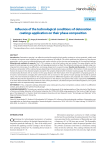
Статья научная
Introduction. Detonation spraying is an effective method for applying high-quality coatings to various materials, widely used in industry to improve wear resistance and corrosion resistance of surfaces. This article examines the influence of key process parameters, such as gun-to-substrate distance and nozzle velocity, on the structure and properties of the resulting coatings. Materials and methods of research. The Ti–TiO2 coatings on hot-rolled carbon steel are studied. The spray distance and the speed of nozzle passage are varied while the rest spraying parameters are fixed. The obtained coatings were studied using scanning electron microscopy, X-ray diffraction, and energy-dispersive X-ray spectroscopy. Results and discussion. It is found that the phase composition of the coating changes depending on the detonation spray conditions. The fraction of rutile exceeds the fraction of anatase in the obtained samples except for the samples obtained with the fastest nozzle passage. The rutile fraction monotonically decreases with an increase in the spray distance with fixed values of the rest parameters of spraying process. It is found a nonmonotonic changing the rutile fraction with an increase in the speed of nozzle passage and found its optimal values. Two new theoretical models for the spray process based on differential equations are proposed, the solutions of which sufficiently describe the dependencies of the rutile fraction on the distance and speed of the nozzle, respectively. Conclusion. It has been demonstrated that the theoretical values of the parameters, calculated using the formulated equations, are in good agreement with the experimentally measured values.
Бесплатно
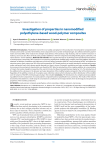
Investigation of properties in nanomodified polyethylene-based wood-polymer composites
Статья научная
Introduction. Polyethylene is by far the most widely used polymer in the production of wood-polymer composites both in Russia and in other countries. Nevertheless, these composites have a number of disadvantages: low adhesion between polymer matrix and wood filler, which reduces the strength characteristics of the products, high elasticity, and low weather resistance. In industry, such issues are often solved by using complex additives in the form of granules including binding agents, lubricants, and various thermo- and UV-stabilizers. Methods and materials. New experimental data on technological and operational characteristics of wood-polymer composites (WPC) based on low-pressure polyethylene modified with complex processing additive have been obtained. In addition to stabilizers and lubricants, multi-wall carbon nanotubes (MWCNT) were introduced in WPC to facilitate the extrusion process, their content was 30% of the total composition. WPC-based products are mainly intended for outdoor performance under mechanical load, which places special demands on them in terms of strength, weathering and water resistance. Results. An increase in the mechanical characteristics was found for WPC after the introduction of the complex additive: at a concentration of 2.6 phr, the tensile strength increased by 35%, and at 53.3 phr, the flexural strength became higher by 12%. The introduction of the additive led to a decrease in the abrasion and water absorption of the modified sample compared to that of the initial material. Regardless of the additive content, all the samples were uniformly colored, which indicated a uniform distribution of the modifier over the volume of the WPC melt during processing in the extruder. Conclusion. The introduction of a complex processing stabilizing additive into the composition of a wood-polymer composite based on polyethylene was carried out. The results of the research showed that the additive in a wide range of concentrations contributes to the improvement of the technological and operational properties of the resulting composites.
Бесплатно
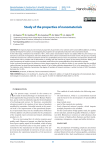
Study of the properties of nanomaterials
Статья научная
To improve physical and mechanical properties of pavements new materials with nanomodified additives are being actively developed. The authors are investigating the properties of road petroleum bitumen with nanomaterial Taunit. At the initial stage, oil bitumen was heated to 100о C. Then carbon nanomaterial «Taunit» was added. After that, the mixture was stirred in an ultrasonic homogenizer until even distribution of the carbon nanomaterial in the total volume. The process of cooling of the final structure was carried out until the end of the crystallization process. Then, the specimens are exposed to tension and strength tests with a constant rate of deformation or loading until the moment of rupture on the testing machines. Mixing with other components of asphalt concrete in the standard mode follows the nanomodification of the bituminous mixture. Under increased temperatures the bitumen mixture keeps properties of an effective binder. It was revealed that the modified carbon bitumen has good thermal properties, namely, it has a higher softening temperature (Δt is in the range from 6 to 10ºС). The indicator, which indirectly characterizes the degree of hardness of bitumen solutions, is within the limits of GOST standards, decreases by 15–20%.
Бесплатно
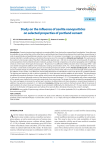
Study on the influence of zeolite nanoparticles on selected properties of portland cement
Статья научная
Introduction. Cement microstructure imaging is an emerging field of non-destructive compositional investigation. Some data may be available via one method but not the other due to various physical and chemical mechanisms that could cause cement decay. In order to quantitatively and qualitatively evaluate cement stone, it is necessary to investigate it as a complex multi-phase composite material, identify its crystalline phases, and estimate the precise size of its nanoparticles. Materials and methods. This work presents the results of a microscopic study of the effect of Nanozeolites (particle size ≤ 100 nm) on cements for cementing wells. To study the surface properties (chemical bonds between molecules, analysis of mineral composition, and surface topography and morphology) of class G cement stone, three types of microscopes – IR spectrum, X-ray diffraction (XRD), and atomic force microscopy (AFM) – were used. Zeolite nanoparticle additives were introduced at varying concentrations (0.5%, 1%, 1.5% by weight of cement) after 8 hours of curing in a water bath at atmospheric pressure and a heating temperature of 60оC (140оF). Results and discussion. The infrared spectra revealed changes in surface properties, indicating a decrease in free water and an increase in the strength of the system with the addition of nano zeolite. X-ray diffraction method (XRD) allowed for the identification of the main phases of crystalline hydration. The highest peak intensity is due to calcium hydroxide CH, which decreases with the addition of nano zeolite. This phenomenon elucidates the pozzolanic behavior of nano zeolite, which reacts with precipitated calcium hydroxide upon hydration to form C–S– H, reduces the calcium hydroxide content of the layered structure and increases C–S–H. The topography and surface morphology of the samples were studied at the nanoscale using atomic force microscopy. The images show the nanoparticles propagate along the cracks and appear to increase the surface layer's resistance to deformation and stress relaxation in cement-based materials. In addition, they promote viscoelastic C–S–H behavior. Conclusion. Adding nano zeolite to Portland cement affects the process of early hydration of cement stone and increases its early strength. Additionally, the introduction of 1.5% nano zeolite into cement results in the formation of irregular peaks and valleys of low porosity filler, ultimately enhancing the cement's strength.
Бесплатно
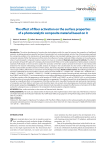
Статья научная
Introduction. The active development of construction technologies entails the need to improve the properties of traditional materials, including giving them specific functional characteristics such as photocatalytic activity. One of the promising methods for solving this problem is the introduction of specialized additives into standard building mixes, which include photocatalytic composite materials. Within the framework of this article, the influence of various methods of fiber activation on the surface properties of a photocatalytic composite material created on its basis is considered. Materials and research methods. The effect of pre-activation of basalt (BF), glass (GF) and glass alkali-resistant (GAF) fibers on the surface properties of photocatalytic composite materials (PCM) based on them has been studied. The activation of the fiber surface consisted in thermal (T) and chemical (AA) treatment. The research methodology included: analysis of changes in the concentration of active centers of Brensted acids on the fiber surface before and after activation of their surface, after direct deposition of titanium dioxide on the obtained samples of various types of fibers, followed by an assessment of morphological changes. Results and discussions. The following growth trend has been established for the total number of active centers for PCM: PCM(BF+Т) → PCM(GF+AA) → PCM(BF+AA) → PCM(GAF+AA) → PCM(GF) → PCM(GAF+Т) → PCM(GAF) → PCM(GF+Т) → PCM(BF). According to the results of scanning electron microscopy, it was found that PCM(GF) and PCM(GAF+T) are characterized by a more uniform distribution of titanium dioxide particles over the entire surface of the fiber, creating a film-like appearance, unlike samples of PCM(BF) and PCM(GF), as well as PCM(GAF+AA), on which titanium dioxide particles are unevenly distributed, forming growths or aggregates. The analysis showed that sol-gel deposition of titanium dioxide has a significant effect on the properties of the fiber surface, which may affect the physical and mechanical characteristics of composites and their ability to self-clean, and should be taken into account when developing new functional materials with photocatalytic properties. Conclusion. The results obtained made it possible to evaluate the effectiveness of activation of the fiber surface for subsequent use as a substrate in the composition of photocatalytic composite materials.
Бесплатно
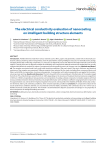
The electrical conductivity evaluation of nanocoating on intelligent building structure elements
Статья научная
Introduction. Flexible elements made from various materials such as films, papers and geotextiles, coated with an electrically conductive coating containing carbon nanoparticles, have the potential for creating intelligent structures. To rationally choose, design, and apply electrically conducting components, it is necessary to objectively assess their behavior throughout the life cycle of these objects. Currently, there are no objective methods for evaluating such components. Methods and tools are needed that can not only evaluate initial electrical conductivity values of components but also predict dynamics of changes over time. Methods and Materials. The samples were tested under cyclic multi-axial stretching conditions. After each stretch, the strain, thickness, and electrical resistance of the samples were measured. Different materials were selected for the study, including films, nonwoven fabrics, and fabrics which differ in composition, structure, and properties. A composition with carbon nanoparticles was applied to the materials using screen printing. Results and discussion. The tests showed that the irreversible part of deformation of the sample ranged from 8% to 75%, while thickness varied from 6% to 100% depending on the structure of materials. Electrical resistance ranged from 25 Ohms to 5 KOhms, depending on test parameters and composition of coating-substrate composite. Correlation analysis confirmed strong correlation between electrical resistivity and sample deformation with correlation coefficient ranging between 0.6 and 0.78. An approximation was used to derive empirical equations that can be used to predict the reliability of flexible, electrically conductive elements under cyclic stretching conditions, which simulate operating conditions. Conclusion. A comparative analysis of test results under these conditions allowed us to recommend nonwoven fabrics and fabrics with a thickness of 0.5–0.7 mm for use as flexible electrically conducting elements. This method is recommended for objective assessment of changes in the properties of these components in intelligent building structures.
Бесплатно
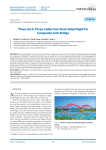
Three-Arch, Three-Cable Face Steel-Sided Rigid Tie Composite Arch Bridge
Статья научная
This essay proposes a new structural system for a large span three-arch, three-cable face steel edge main beamrigid tie composite arch bridge. The authors invented a new structural form of a steel edge main girder rigid tie, and developed and designed a key arch-bar three-dimensional six-way space node structure. The analysis of results show that: compared with the traditional arch bridge, the large span three-arch three-cable face steel-sided main beam rigid ties composite arch bridgeis beautiful in shape, hasareasonable structure and efficient construction. It is a high-strength, high-performance composite structural system, with better strength, stiffness, stability and dynamic performance, which overcomes the large span ultra-wide bridge deck arch bridge horizontal thrust, poor transverse stability, and the key technical problems of acable joint control. The proposed structural form has a wide range of engineering application prospects.
Бесплатно
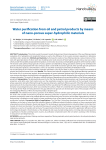
Water purification from oil and petrol products by means of nano-porous super-hydrophilic materials
Статья научная
Introduction. This article reveals the research results of physical and chemical properties of the new filtering material, evaluation of its hydrophilic and oleophobic features as well as the efficiency of oil-in-water emulsions separation in laboratory conditions and in production. Methods and materials. As the base for creation of new filtering material a natural mixture of minerals with good prevalence of silicon earth also including some small amounts of fissile hydrous silicates (mica, clay) was chosen, which provide the durability of granulated end product at reservation of porosity and hydrophilic properties of the material surface. The research used spherical shape granules of various particle size obtained by drying, granulation and firing. Prior to filtration the granules are being impregnated with water aiming to obtain a water shell around each granule, which provides granules protection from oil and petrol products contamination as well as an easy filter cleaning by backwashing in fluidization mode. For the lab testing of oil-in-water emulsions separation parameters a test rig was built. In process a set of various tool methods of physical and chemical research was used. Results. The chemical and mineral composition of the developed filtering material and the results of its X-ray-structural analysis, photomicrography of ground substrate obtained with SEM are given as well as the porous structure data (pores size distribution and aggregate pores of granules material) obtained by the method of low-temperature nitrogen adsorption. The results of laboratory and pilot testing of separating and accumulating ability of the filtering material are presented. Interpretation. The obtained data prove the fact that the developed material possesses over the prominent hydrophilic properties, while after water shell creation also over the oleophobic properties. Upon exploration of the two liquid immiscible phases separation during the filtering through the granules obtained, a significant efficiency growth of the filter after attaining the special amount of oil and petrol products retained by the filter was detected. The efficiency increase of the filter is connected with formation of a prolonged structure, which was named by the authors a “fluid net”, created by the oil and petrol products entrapped. The strings of that “fluid net” being formed in the gaps between the granules are decreasing the sizes of the passages which lets the entrapping efficiency of finer oil and petrol products droplets grow. Conclusion. The obtained nano-porous granules of the filtering material exhibit super-hydrophilic properties and based on the water shell created around them provide the following: protection of granules from contamination with oil and petrol products contained in water to be purified; effective and not decreasing over the course of time filter regeneration by means of backwashing in fluidization mode; quality of water purification from oil and petrol products at the level of the most expensive purification methods. Prospective fields of applications. The “OreFilter” technology developed has passed the pilot scale validation on the basis of more than fifty industrial objects of different industrial branches (mainly on those connected with oil production and oil refining) in Russia and abroad. The technology is now being tested on industrial objects in the Near East, Canada, US, Brazil and Australia. The industrial filtering units using “OreFilter” technology are already in operation on Russian enterprises as well as in Sweden and Germany. The experimental-industrial tests have proved the application efficiency of the technology developed: in food industry; at the detergents and soaps manufacturing plants; at mining and processing plants; at purification of ballast and bilge water at ports; at purification of polluted water after oil tankers washing; in fish farming; in seaquariums and dolphinariums.
Бесплатно
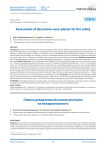
Аssessment of decorative nano-plaster for fire safety
Статья научная
Introduction. In tests for fire and explosion hazard of materials, various factors influence the desired value and its variation. All these factors affect the correct classification of a material into a fire hazard group, which ultimately determines its potential use. For instance, on escape routes from a building, it is essential to use non-combustible materials (Group NС) for finishes. For example, on escape routes from the building, it is necessary to use non-combustible materials (group NС) for finishing. Therefore, to determine the actual group (class), it is necessary to determine not only the desired value, but also its data spread. Methods and materials. Baumit Nanopore decorative plaster was tested for flammability parameters to classify the material as either flammable or nonflammable. Results. Discussion. Tests of decorative plaster Nanopor “Baumit” showed the following results: loss of mass of the sample is P = 7.0±0.3%; temperature increase in the furnace is 4,6±1,7 ºC; duration of stable flame combustion is 1.0± 0.1 s. In accordance with p. 5.2 of GOST 30244-94 this building material is referred to non-combustible materials, because the values of flammability parameters are within the permissible norm. Loss of mass of decorative plaster samples after fire exposure decreased by only 7%, due to the loss of moisture during heating of plaster samples. And the uncertainty on the mass loss of decorative plaster is about 4%. The temperature increase in the oven during the tests of plaster is about 5 ºC, while the norm is not more than 50 ºC. Relative expanded uncertainty on the temperature rise in the furnace is 36%. Duration of stable flame combustion of plaster is 1 s, while the norm is not more than 10 s. The spread of data on this indicator is 10%. Conclusion. The analysis of the obtained data showed that the expanded uncertainty on flammability parameters ranges from 4 to 40%, which significantly affects the deviation of the measurement result from the true value, as well as the correctness of assigning the group (class) of fire danger to the material.
Бесплатно

